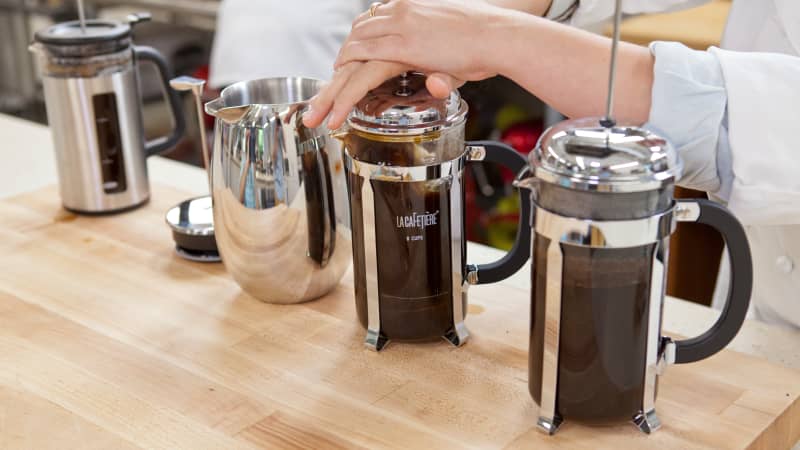Espresso Machines
Equipment Review
French press coffee makers are not only elegant, but they also can potentially deliver a thicker, more full-bodied cup of coffee.
Published Nov. 1, 2013. Appears in America's Test Kitchen TV Season 15: Classic Fare with Flair

The French press (or cafetière à piston, as the French call it) uses a piston-like mechanism to force ground coffee through hot water, sending the spent grounds to the bottom of the pot and leaving a full-bodied brew on top. Oily and thick from minute particles of the grind suspended in the brew, French press coffee is impossible to confuse with drip coffee.
But there are potential drawbacks: The mass of steeped coffee grounds creates pressure, making it hard to push down the filter, sometimes shattering glass pots or spewing coffee out of the pot’s spout. Also, heat escapes glass pots quickly. Some people dislike suspended coffee particles in their brew. And spent grounds are messy, wet, and hard to dislodge from the bottom of the pot when it’s time to clean up.
Recently, we’ve seen a number of French presses that promise to address these issues, so we rounded up six 8-cup models priced from about $25 to roughly $120, including our favorite traditional glass pot. We brewed and tasted pots of coffee, compared the coffees’ temperature after brewing, and cleaned the pots by hand. Would we be able to find the best French press coffee maker in our lineup?
All the pots operated similarly. One model uses a two-layer fine-mesh filter in the shape of a basket, surrounded by a two-layer silicone gasket—modifications that kept fine sediment out of the coffee. Many tasters enjoyed its “smoother” cup, but others bemoaned its “thin” texture, complaining that the result was not much like French press coffee. Compared with other models that we tested, this model's big, basketlike filter was also a bit harder to press down—and fussier to clean. Two different pots received slightly lower overall ratings for coffee quality than others (with some complaints about bitterness, despite high marks for good body). (Presses that produced lesser-quality coffee were slightly downgraded.) Both of these pots use a mesh filter with a coiled spring around its perimeter to keep out grounds during pressing, rather than a silicone strip like newer models. But a third pot got high marks with the same traditional spring-style filter. The difference turned out to be the amount of “play” in the stem as you press: With more lateral movement, those two lesser pots let the filter tip slightly, allowing more grounds into the brew. Unlike other pots, these two also lacked a grille over the spout to capture larger particles as you pour.
Insulated pots kept the coffee hotter. The all-steel models in our lineup use double-walled insulation to retain heat, which also eliminated the risk of shattering. While purists say that flavor is ...

The mission of America’s Test Kitchen Reviews is to find the best equipment and ingredients for the home cook through rigorous, hands-on testing. We stand behind our winners so much that we even put our seal of approval on them.

Lisa is an executive editor for ATK Reviews, cohost of Gear Heads on YouTube, and gadget expert on TV's America's Test Kitchen.

This is a members' feature.